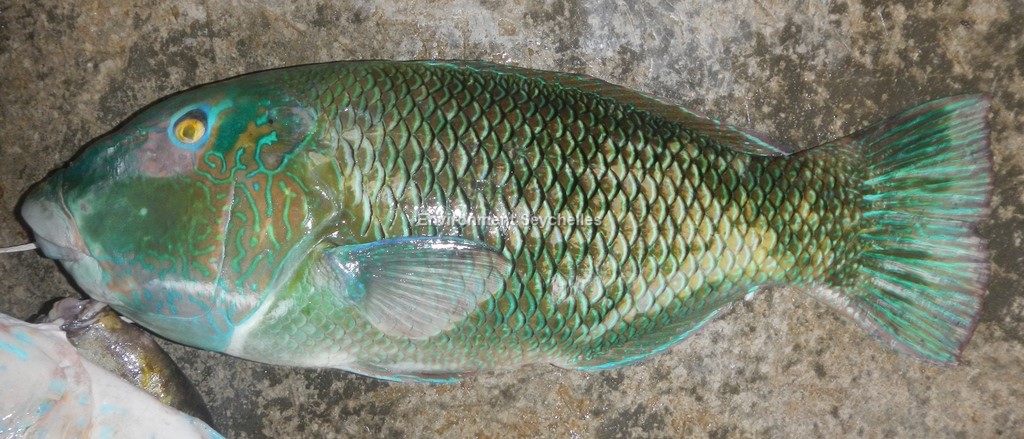Description:
Dorsal spines: 9; Dorsal rays: 10-11; Anal spines: 3; Anal rays: 11.
Full-bodied wrasse. Lips very thick and fleshy. A single pair of strongly projecting canine teeth anteriorly in each jaw, followed by a row of small blunt conical teeth.
Dorsal fin continuous and relatively low. Caudal fin truncate to slightly rounded.
Colour. Changes dramatically from juvenile to adult, see references listed below for full details.
Small female posterior body (from a curving line from origin of dorsal fin to origin of anal fin) blackish grading to yellow with blue-green spots posteriorly on caudal
peduncle and fin (narrow green bar and dark margin on posterior of scales).
Large female dark green posteriorly (oblique demarcation as above) the scales rimmed in black, with a vertical green line or spot on each scale. Head and anterior body light
green dorsally and pale ventrally. Irregular bands on snout and above eye. Light blue rim around eye. Distinctive complex marking behind eye.
Male posterior body dark green each scale with narrow pale blue-green and black posterior margin. Head green dorsally with irregular green to blue-green bands, including a
blue ring around eye. Cheek with large green diffuse patch and operculum pinkish white with irregular light blue lines and spots. Lips and ventral part of head mainly pale
blue. Chest and abdomen pinkish white with a light blue spot or arc on scales.
Size:
Maturity: Lm unknown. Range unknown. Max Length: 37cm TL. (43 cm TL)
Specimen recorded 11/03/17 (Victoria, Mahe) by John Nevill measured 43 cm TL .
Habitat and Ecology:
Inhabits coral reefs, sub-tidal reef flats, lagoons, outer reef slopes and drop-offs (Depth 1-40 m, usually 5-30 m). Solitary or in small groups. Juveniles occur inshore,
found among branching corals while adults found in areas of mixed sand, rubble, and coral. Diet varies from demersal planktonic crustaceans to hard-shelled invertebrates
with growth. Adults feed by taking in mouthfuls of sand to sort out the invertebrates, the sand being expelled through the gill openings. Oviparous, with distinct pairing
during breeding.
Fishery Status:
This species is not protected or subject to fishery regulations. It is caught in the fish trap fishery, but is an occasional and not abundant component of the catch.
Notes:
References:
Bray, D.J. Hemigymnus melapterus in Fishes of Australia, http://136.154.202.208/home/species/245 (21/03/20).
Froese, R. & D. Pauly. (Eds.) (2019). FishBase. https://www.fishbase.se/summary/5636 (05/06/19).
Randall, J.E. (1986). Labridae. p. 683-706. In M.M. Smith and P.C. Heemstra (eds.) Smiths' sea fishes. Springer-Verlag, Berlin.
Shea, S. et al. (2010). Hemigymnus melapterus. The IUCN Red List 2010: https://dx.doi.org/10.2305/IUCN.UK.2010-4.RLTS.T187476A8545602.en. (21/03/20).
Citation:
Nevill, J.E.G. (2019). Hemigymnus melapterus, Blackeye thicklip. Seychelles Seatizens. www.seatizens.sc. https://seatizens.sc/species/hemigymnus-melapterus-bloch-1791/ (updated 12/07/22).




There are no comments